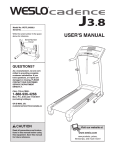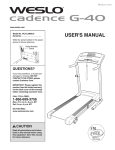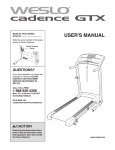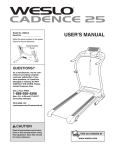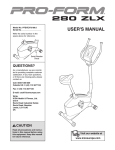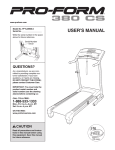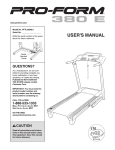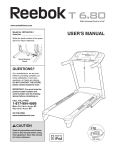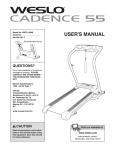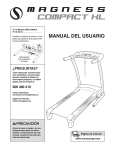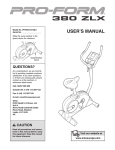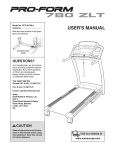Download Weslo compact SL User`s manual
Transcript
Model No. WETL30708.0 Serial No. Write the serial number in the space above for reference. Serial Number Decal QUESTIONS? As a manufacturer, we are committed to providing complete customer satisfaction. If you have questions, or if there are missing parts, please contact us at the numbers or addresses listed below: Call: 08457 089 009 Outside UK: 0 (44) 113 3877133 Fax: 0 (44) 113 3877125 E-mail: [email protected] Write: ICON Health & Fitness, Ltd. Unit 4 Revie Road Industrial Estate Revie Road, Beeston Leeds, LS11 8JG UK CAUTION Read all precautions and instructions in this manual before using this equipment. Save this manual for future reference. USER'S MANUAL TABLE OF CONTENTS WARNING DECAL PLACEMENT . . . . . . . . . . . . . . . . . . . . . . . . . . . . . . . . . . . . . . . . . . . . . . . . . . . . . . . . . . . . . .2 IMPORTANT PRECAUTIONS . . . . . . . . . . . . . . . . . . . . . . . . . . . . . . . . . . . . . . . . . . . . . . . . . . . . . . . . . . . . . . . . .3 BEFORE YOU BEGIN . . . . . . . . . . . . . . . . . . . . . . . . . . . . . . . . . . . . . . . . . . . . . . . . . . . . . . . . . . . . . . . . . . . . . . .5 ASSEMBLY . . . . . . . . . . . . . . . . . . . . . . . . . . . . . . . . . . . . . . . . . . . . . . . . . . . . . . . . . . . . . . . . . . . . . . . . . . . . . . .6 OPERATION AND ADJUSTMENT . . . . . . . . . . . . . . . . . . . . . . . . . . . . . . . . . . . . . . . . . . . . . . . . . . . . . . . . . . . .15 HOW TO FOLD AND MOVE THE TREADMILL . . . . . . . . . . . . . . . . . . . . . . . . . . . . . . . . . . . . . . . . . . . . . . . . . .20 TROUBLESHOOTING . . . . . . . . . . . . . . . . . . . . . . . . . . . . . . . . . . . . . . . . . . . . . . . . . . . . . . . . . . . . . . . . . . . . . .22 EXERCISE GUIDELINES . . . . . . . . . . . . . . . . . . . . . . . . . . . . . . . . . . . . . . . . . . . . . . . . . . . . . . . . . . . . . . . . . . .25 PART LIST . . . . . . . . . . . . . . . . . . . . . . . . . . . . . . . . . . . . . . . . . . . . . . . . . . . . . . . . . . . . . . . . . . . . . . . . . . . . . . .26 EXPLODED DRAWING . . . . . . . . . . . . . . . . . . . . . . . . . . . . . . . . . . . . . . . . . . . . . . . . . . . . . . . . . . . . . . . . . . . . .28 ORDERING REPLACEMENT PARTS . . . . . . . . . . . . . . . . . . . . . . . . . . . . . . . . . . . . . . . . . . . . . . . . . .Back Cover RECYCLING INFORMATION . . . . . . . . . . . . . . . . . . . . . . . . . . . . . . . . . . . . . . . . . . . . . . . . . . . . . . . . .Back Cover WARNING DECAL PLACEMENT This drawing shows the location(s) of the warning decal(s). If a decal is missing or illegible, call the telephone number on the front cover of this manual and request a free replacement decal. Apply the decal in the location shown. Note: The decal(s) may not be shown at actual size. WESLO is a registered trademark of ICON IP, Inc. 2 IMPORTANT PRECAUTIONS WARNING: To reduce the risk of serious injury, read all important precautions and instructions in this manual and all warnings on your treadmill before using your treadmill. ICON assumes no responsibility for personal injury or property damage sustained by or through the use of this product. 1. Before beginning this or any exercise program, consult your physician. This is especially important for persons over age 35 or persons with pre-existing health problems. cuit. No other appliance should be on the same circuit. When replacing the fuse, an ASTA approved BS1362 type should be fitted to the fuse carrier. A 13 amp fuse should be used. 2. It is the responsibility of the owner to ensure that all users of this treadmill are adequately informed of all warnings and precautions. 12. If an extension cord is needed, use only a 3conductor, 14-gauge (1 mm2) cord that is no longer than 5 ft. (1.5 m). 3. Use the treadmill only as described in this manual. 13. Keep the power cord away from heated surfaces. 4. Place the treadmill on a level surface, with at least 8 ft. (2.4 m) of clearance behind it and 2 ft. (0.6 m) on each side. Do not place the treadmill on a surface that blocks any air openings. To protect the floor or carpet from damage, place a mat under the treadmill. 14. Never move the walking belt while the power is turned off. Do not operate the treadmill if the power cord or plug is damaged, or if the treadmill is not working properly. (See TROUBLESHOOTING on page 22 if the treadmill is not working properly.) 5. Keep the treadmill indoors, away from moisture and dust. Do not put the treadmill in a garage or covered patio, or near water. 15. Read, understand, and test the emergency stop procedure before using the treadmill (see HOW TO TURN ON THE POWER on page 17). 6. Do not operate the treadmill where aerosol products are used or where oxygen is being administered. 16. Never start the treadmill while you are standing on the walking belt. Always hold the handrails while using the treadmill. 7. Keep children under age 12 and pets away from the treadmill at all times. 17. The treadmill is capable of high speeds. Adjust the speed in small increments to avoid sudden jumps in speed. 8. The treadmill should be used only by persons weighing 265 lbs. (120 kg) or less. 18. Never leave the treadmill unattended while it is running. Always remove the key, unplug the power cord, and switch the reset/off circuit breaker to the off position when the treadmill is not in use. (See the drawing on page 5 for the location of the reset/off circuit breaker.) 9. Never allow more than one person on the treadmill at a time. 10. Wear appropriate exercise clothes when using the treadmill. Do not wear loose clothes that could become caught in the treadmill. Athletic support clothes are recommended for both men and women. Always wear athletic shoes; never use the treadmill with bare feet, wearing only stockings, or in sandals. 19. The pulse sensor is not a medical device. Various factors, including your movement, may affect the accuracy of heart rate readings. The pulse sensor is intended only as an exercise aid in determining heart rate trends in general. 11. When connecting the power cord (see page 15), plug the power cord into an earthed cir- 3 20. Do not attempt to raise, lower, or move the treadmill until it is properly assembled. (See ASSEMBLY on page 6, and HOW TO FOLD AND MOVE THE TREADMILL on page 20.) You must be able to safely lift 45 lbs. (20 kg) to raise, lower, or move the treadmill. 24. Never drop or insert any object into any opening on the treadmill. 25. 21. When folding or moving the treadmill, make sure that the storage latch is holding the frame securely in the storage position. 22. Do not change the incline of the treadmill by placing objects under the treadmill. 23. Inspect and properly tighten all parts of the treadmill regularly. DANGER: Always unplug the power cord immediately after use, before cleaning the treadmill, and before performing the maintenance and adjustment procedures described in this manual. Never remove the motor hood unless instructed to do so by an authorized service representative. Servicing other than the procedures in this manual should be performed by an authorized service representative only. 26. This treadmill is intended for in-home use only. Do not use this treadmill in any commercial, rental, or institutional setting. SAVE THESE INSTRUCTIONS 4 BEFORE YOU BEGIN Thank you for selecting the new WESLO® COMPACT SL treadmill. The COMPACT SL treadmill offers a selection of features designed to make your workouts at home more effective. And when youʼre not exercising, the unique treadmill can be folded up, requiring less than half the floor space of other treadmills. ing this manual, please see the front cover of this manual. To help us assist you, please note the product model number and serial number before contacting us. The model number and the location of the serial number decal are shown on the front cover of this manual. Before reading further, please familiarize yourself with the parts that are labeled in the drawing below. For your benefit, read this manual carefully before using the treadmill. If you have questions after readAccessory Tray Console Pulse Sensor Handrail Storage Latch Key/Clip Upright Reset/Off Circuit Breaker Walking Belt Foot Rail Platform Cushion Incline Pin Idler Roller Adjustment Bolts 5 ASSEMBLY Assembly requires two persons. Set the treadmill in a cleared area and remove all packing materials; do not dispose of the packing materials until assembly is completed. Note: The underside of the treadmill walking belt is coated with high-performance lubricant. During shipping, a small amount of lubricant may be transferred to the top of the walking belt or the shipping carton. This does not affect treadmill performance. If there is lubricant on top of the walking belt, simply wipe off the lubricant with a soft cloth and a mild, non-abrasive cleaner. Assembly requires the included hex keys and your own Phillips screwdriver mallet , adjustable wrench , and wire cutters . , rubber Use the drawings below to identify the assembly hardware. The number in parentheses below each drawing is the key number of the part, from the PART LIST near the end of this manual. The number after the parentheses is the quantity needed for assembly. Note: If a part is not in the hardware kit, check to see if it is preattached to one of the parts to be assembled. To avoid damaging plastic parts, do not use power tools for assembly. Extra hardware may be included. M5 Star Washer (12)–2 5/16" Star Washer (2)–6 #10 x 1" Tek Screw (43)–2 M10 Star Washer (8)–2 M4.2 x 19mm Screw (10)–6 M5 x 16mm Screw (13)–2 M8 x 16mm Bolt (17)–6 M10 Washer (4)–2 M10 x 53mm Patch Bolt (18)–4 M10 x 110mm Bolt (15)–2 6 M10 Flat Washer (16)–4 M4.2 x 19mm Tek Screw (14)–4 1. Make sure that the power cord is unplugged. 1 Orient the Base (101) as shown. Attach four Base Feet (100) to the Base (101) in the locations shown with four M4.2 x 19mm Tek Screws (14). 14 100 14 101 100 14 100 14 100 2. Identify the Right Upright (98), which has a large hole in the location shown. 2 Orient the Right Upright (98) and the Base (101) as shown. Attach the Right Upright to the Base with two M10 x 53mm Patch Bolts (18) and two M10 Flat Washers (16); do not fully tighten the Patch Bolts yet. 98 Large Hole 101 16 18 7 3. Orient the Left Upright (96) and the Base (101) as shown. Attach the Left Upright to the Base with two M10 x 53mm Patch Bolts (18) and two M10 Flat Washers (16); do not fully tighten the Patch Bolts yet. 3 101 96 16 18 4. With the help of a second person, raise the Uprights (96, 98) so the Base (101) is flat on the floor as shown. Next, position the front of the Frame (67) between the Uprights. Wire Tie 4 96 See the inset drawing. Locate the wire tie inside the lower end of the Right Upright (98). Wrap the wire tie around the end of the Wire Harness (97). Next, locate the opposite end of the wire tie, which is extending from the top of the Right Upright. Pull the wire tie until the Wire Harness is routed completely through the Right Upright. 98 98 67 Wire Tie 8 97 Wire Tie 101 97 5. Have a second person raise the Frame (67) and hold it until step 6 is completed. 5 Hold an Upright Spacer (54) between the Right Upright (98) and the Frame (67) as shown. Attach the Right Upright to the Frame with an M10 x 110mm Bolt (15), an M10 Washer (4), and an M10 Star Washer (8); do not fully tighten the Patch Bolt yet. Be careful not to pinch the Wire Harness (97). 98 67 54 4 97 6. Hold the remaining Upright Spacer (54) between the Left Upright (96) and the Frame (67) as shown. Attach the Left Upright to the Frame with an M10 x 110mm (15), an M10 Washer (4), and an M10 Star Washer (8); do not tighten the Patch Bolt yet. 6 96 54 15 9 4 8 67 8 15 7. Have a second person lift and hold the Frame (67) until step 8 is completed. 7 Next, place the cylinder end of the Gas Spring (1) near the bracket on the Base (101). 67 See the two small inset drawings. Using your fingernail or the end of a screwdriver, press on the end of the Gas Spring Pin (7) to loosen it from the Gas Spring (1). Next, rotate the Gas Spring Pin and pull it out of the Gas Spring. Be careful to avoid losing the Gas Spring Pin. 7 See the lower drawing. Press the cylinder end of the Gas Spring (1) onto the ball on the bracket. Next, insert the end of the Gas Spring Pin (7) through two of the small holes in the end of the Gas Spring. Then, rotate the Gas Spring Pin until it clips onto the Gas Spring. 101 1 7 Bracket 7 Cylinder Bracket 7 1 8. Raise the Gas Spring (1) to a vertical position. Remove the Gas Spring Pin (7) from the raised end of the Gas Spring as described in step 7. If necessary, rotate the Gas Spring to align the end of the Gas Spring with the ball on the bracket on the Frame (67). 8 Holes 67 Bracket 7 Then, press the end of the Gas Spring (1) onto the ball. Note: It may be necessary to move the Frame forward or backwards as you press the Gas Spring onto the ball. See the lower drawing. Insert the Gas Spring Pin (7) into the two indicated small holes in the end of the Gas Spring (1) Then, rotate the Gas Spring Pin until it clips onto the Gas Spring. Note: Extra Gas Spring Pins are included. Holes Lower the Frame (67) to the floor. 7 10 1 1 9. Identify the Right Handrail Cover (95) and the Left Handrail Cover (93). Slide the end of the Right Handrail (94) through the hole in the Right Handrail Cover, and slide the end of Left Handrail (92) through the hole in the Left Handrail Cover. 9 95 Attach the Handrail Covers (93, 95) to the Handrails (92, 94) with two M4.2 x 19mm Screws (10) in the locations shown. 93 Hole 10. Set the Console (52) face down on a soft surface to avoid scratching the Console. Hold the Right Handrail (94) near the Console as shown. Insert the console wire into the large hole on the side of the Right Handrail and out the hole on top as shown. 10 Hole 94 10 10 92 94 Console Wire Large Hole 52 11 11. Attach the Right Handrail (94) to the Console (52) with an M5 x 16mm Screw (13), an M5 Star Washer (12), and two M4.2 x 19mm Screws (10). Make sure that no wires are pinched. Start all three Screws before tightening any of them. Tighten the M5 x 16mm Screw and then tighten the M4.2 x 19mm Screws. Do not overtighten the Screws. 11 94 13 12 Attach the Left Handrail (92) to the other side of the Console (52) in the same way. Note: There are no wires on the left side of the Console. 92 41 12 13 10 Remove the plastic ties from the Right Handrail (94) and the Left Handrail (92). If necessary, press the M8 Cage Nuts (41) into place. 52 12. Have a second person hold the Console (52) near the Right Upright (98) and the Left Upright (not shown). 12 Connect the Wire Harness (97) to the console wire. See the inset drawing. The connectors should slide together easily and snap into place. If they do not, turn one connector and try again. IF THE CONNECTORS ARE NOT CONNECTED PROPERLY, THE CONSOLE MAY BE DAMAGED WHEN THE POWER IS TURNED ON. Remove the wire tie from the Wire Harness. Insert the connectors and excess wire into the Right Upright (98). 52 97 Next, set the Console (52) onto the top of the Right Upright (98) and the Left Upright (not shown). Make sure that no wires are pinched. Console Wire 98 12 Wire Tie Console Wire 97 41 10 13. Attach the Console (52) to the Uprights (96, 98) with six M8 x 16mm Bolts (17) and six 5/16" Star Washers (2). Start all six Bolts before tightening any of them. 13 2 52 17 2 17 2 96 2 17 98 14. With the help of a second person, lower the Uprights (96, 98) as shown. 14 See the lower drawing. Position the Uprights (96, 98) so that the Frame (67) is centered between the Uprights. Firmly tighten the M10 x 53mm Patch Bolts (18) and the M10 x 110mm Bolt (15) on each side of the treadmill (only one side is shown). Do not overtighten the M10 x 110mm Bolts. Side View 96, 98 15 18 View from Above 96 13 67 98 15. Attach the Latch Housing (62) to the Left Upright (96) with two #10 x 1" Tek Screws (43). Make sure that the Latch Housing is oriented as shown. Do not overtighten the Screws. 15 43 16. Place the treadmill in the storage position (see HOW TO FOLD AND MOVE THE TREADMILL on page 20). 16 Insert the Incline Pins (24) at the desired incline level (see HOW TO CHANGE THE INCLINE OF THE TREADMILL on page 19). 24 62 96 24 Lower the treadmill (see HOW TO LOWER THE TREADMILL FOR USE on page 21). 17. Make sure that all parts are properly tightened before you use the treadmill. Note: Extra hardware may be included. Keep the included hex keys in a secure place; the large hex key is used to adjust the walking belt (see pages 23 and 24). To protect the floor or carpet, place a mat under the treadmill. 14 OPERATION AND ADJUSTMENT THE PRE-LUBRICATED WALKING BELT Your treadmill features a walking belt coated with high-performance lubricant. IMPORTANT: Never apply silicone spray or other substances to the walking belt or the walking platform. Such substances will deteriorate the walking belt and cause excessive wear. HOW TO PLUG IN THE POWER CORD This product must be earthed. If it should malfunction or break down, earthing provides a path of least resistance for electric current to reduce the risk of electric shock. This product is equipped with a power cord having an equipment-earthing conductor and an earthing plug. IMPORTANT: If the power cord is damaged, it must be replaced with a manufacturer-recommended power cord. See drawing 1. Plug the indicated end of the power cord into the socket on the treadmill. See drawing 2. Press the pins on the power cord into the metal clips in the adapter as shown. Close the adapter cover over the end of the power cord and tighten the screw in the adapter. IMPORTANT: Make sure that the adapter cover is secure and the screw has been tightened before using the power cord. See drawing 3. Plug the power cord into an appropriate outlet that is properly installed and earthed in accordance with all local codes and ordinances. IMPORTANT: The treadmill is not compatible with RCD-equipped outlets. DANGER: 1 Socket on Treadmill 2 Adapter Cover Screw Adapter 3 Metal Clips Pins Outlet Improper connection of the equipment-earthing conductor can result in an increased risk of electric shock. Check with a qualified electrician or serviceman if you are in doubt as to whether the product is properly earthed. Do not modify the plug provided with the product—if it will not fit the outlet, have a proper outlet installed by a qualified electrician. 15 CONSOLE DIAGRAM Key Clip FEATURES OF THE CONSOLE To turn on the power, see page 17. To use the manual mode of the console, see page 17. To use a speed workout, see page 19. The treadmill console offers a selection of features designed to make your workouts more effective. When you select the manual mode of the console, you can change the speed of the treadmill with the touch of a button. As you exercise, the console will display continuous exercise feedback. You can even measure your heart rate using the built-in handgrip pulse sensor. IMPORTANT: If there are sheets of clear plastic on the console, remove the plastic. To prevent damage to the walking platform, wear clean athletic shoes while using the treadmill. The first time you use the treadmill, observe the alignment of the walking belt, and center the walking belt if necessary (see page 24). The console also features four speed workouts. Each workout controls the speed of the treadmill as it guides you through an effective exercise session. 16 HOW TO TURN ON THE POWER HOW TO USE THE MANUAL MODE IMPORTANT: If the treadmill has been exposed to cold temperatures, allow it to warm to room temperature before turning on the power. If you do not do this, you may damage the console displays or other electrical components. Plug in the power cord (see page 15). Next, locate the reset/off circuit breaker on the treadmill frame near the power cord. Switch the circuit breaker to the reset position. 1. Insert the key into the console. See HOW TO TURN ON THE POWER at the left. 2. Select the manual mode. When the key is inserted, the manual mode will be selected. If you have selected a speed workout, reselect the manual mode by pressing the Workout Select button repeatedly until only zeros appear in the displays. Reset Position Next, stand on the foot rails of the treadmill. Find the clip attached to the key (see the drawing on page 16), and slide the clip onto the waistband of your clothes. Then, insert the key into the console. After a moment, the displays will light. IMPORTANT: In an emergency situation, the key can be pulled from the console, causing the walking belt to slow to a stop. Test the clip by carefully taking a few steps backward; if the key is not pulled from the console, adjust the position of the clip. 3. Start the walking belt. To start the walking belt, press the Start button or the Digital Speed increase button. The walking belt will begin to move at 2 km/h. As you exercise, change the speed of the walking belt as desired by pressing the Digital Speed increase and decrease buttons. Each time you press a button, the speed setting will change by 0.1 km/h; if you hold down a button, the speed setting will change in increments of 0.5 km/h. To stop the walking belt, press the Stop button. The time will begin to flash in the display. To restart the walking belt, press the Start button or the Digital Speed increase button. 17 4. Follow your progress with the displays. ment is selected, remove the key, insert the key into the console while holding down the Stop button, and then release the Stop button. An “M” for metric kilometers or an “E” for English miles will appear in the upper display. Press the Digital Speed increase button to change the unit of measurement if desired. When the desired unit of measurement is selected, remove the key and then reinsert it. The lower left display—As you exercise, the lower left display can show the elapsed time and the distance that you have walked or run. 5. Measure your heart rate if desired. The lower right display—The lower right display can show the speed of the walking belt and the approximate number of calories that you have burned. The display also shows your heart rate when you use the handgrip pulse sensor (see step 5). Before using the handgrip pulse sensor, remove the sheets of clear plastic from the metal contacts. In addition, make sure that your hands are clean. Metal Contacts To measure your heart rate, stand on the foot rails and hold the metal contacts—avoid moving your hands. When your pulse is detected, the small heart symbol in the lower right display will flash, one or two dashes will appear, and then your heart rate will be shown. For the most accurate heart rate reading, continue to hold the contacts for about 15 seconds. The upper display— The upper display can show the elapsed time, the distance that you have walked or run, the speed of the walking belt, or the approximate number of calories you have burned. Press the Display Mode button repeatedly until the upper display shows the information that you are most interested in viewing. Note: While information is shown in the upper display, the same information will not be shown in the lower left or right display. 6. When you are finished exercising, remove the key from the console. Step onto the foot rails, press the Stop button, remove the key from the console, and put it in a secure place. To reset the displays, press the Stop button, remove the key, and then reinsert the key. When you are finished using the treadmill, switch the reset/off circuit breaker to the “off” position and unplug the power cord. IMPORTANT: If you do not do this, the treadmillʼs electrical components may wear prematurely. Note: The console can display speed and distance in either kilometers or miles. To see which unit of measure- 18 HOW TO USE A SPEED WORKOUT To stop the workout temporarily, press the Stop button. The time will begin to flash in the display. To restart the workout, press the Start button or the Digital Speed increase button. The walking belt will begin to move at 2 km/h. When the next segment of the workout begins, the treadmill will automatically adjust to the speed setting for the next segment. 1. Insert the key into the console. See HOW TO TURN ON THE POWER on page 17. 2. Select one of the four speed workouts. 4. Follow your progress with the displays. To select a speed workout, press the Workout Select button repeatedly until the number of the desired workout appears in the upper display. The maximum speed setting of the selected workout will appear in the lower right display. See step 4 on page 18. 5. Measure your heart rate if desired. See step 5 on page 18. 6. When you are finished exercising, remove the key from the console. Each workout is divided into 30 one-minute segments. One speed setting is programmed for each segment. Note: The same speed setting may be programmed for consecutive segments. See step 6 on page 18. HOW TO CHANGE THE INCLINE OF THE TREADMILL 3. Press the Start button or the Digital Speed increase button to start the workout. To vary the intensity of your exercise, you can change the incline of the treadmill. There are three incline levels. Before changing the incline, remove the key and unplug the power cord. Next, fold the treadmill to the storage position (see page 20). A moment after you press the button, the treadmill will automatically adjust to the first speed setting of the workout. Hold the handrails and begin walking. To change the incline, first remove the incline pin from one of the incline legs. Adjust the incline leg to the desired position, and then fully reinsert the incline pin. Adjust the other incline leg in the same way. CAUTION: Before using the treadmill, make sure that both incline legs are at the same height and that both incline pins are fully inserted into the incline legs. At the end of each segment of the workout, a series of tones will sound. In addition, if a different speed setting is programmed for the next segment, the speed setting will flash in the display to alert you. When the next segment begins, the speed of the walking belt will automatically adjust to the speed setting for the next segment. After you have adjusted the incline legs, lower the treadmill (see page 21). The workout will continue in this way until you have walked or run for 30 minutes. The walking belt will then slow to a stop. If the speed setting for the current segment is too high or too low, you can override the setting by pressing the Digital Speed buttons; however, when the next segment begins, the treadmill will automatically adjust to the speed setting for the next segment. Incline Pin 19 Incline Leg Incline Pin HOW TO FOLD AND MOVE THE TREADMILL HOW TO FOLD THE TREADMILL FOR STORAGE Remove the key and unplug the power cord. CAUTION: You must be able to safely lift 45 lbs. (20 kg) to raise, lower, or move the treadmill. 1. Hold the metal frame firmly in the location shown by the arrow at the right. CAUTION: To decrease the possibility of injury, do not lift the frame by the plastic foot rails. Make sure to bend your legs and keep your back straight as you raise the frame. Raise the frame about halfway to the vertical position. 2. Move your right hand to the position shown and hold the treadmill firmly. Using your left hand, pull the latch knob to the left and hold it. Raise the frame until the hole in the latch plate is aligned with the latch pin. Slowly release the latch knob; make sure that the latch pin is fully inserted into the latch plate. To protect the floor or carpet from damage, place a mat under the treadmill. Keep the treadmill out of direct sunlight. Do not leave the treadmill in the storage position in temperatures above 85° F (30° C). Frame Frame Latch Pin Latch Knob Latch Plate HOW TO MOVE THE TREADMILL Before moving the treadmill, convert the treadmill to the storage position as described above. Make sure that the latch pin is fully inserted into the latch plate. 1. Hold one handrail and place one foot against one of the wheels. 2. Tilt the treadmill back until it rolls freely on the wheels. Carefully move the treadmill to the desired location. To reduce the risk of injury, use extreme caution while moving the treadmill. Do not move the treadmill over an uneven surface. 3. Place a foot against one of the wheels, and carefully lower the treadmill until it is resting in the storage position. 20 Handrail Wheel HOW TO LOWER THE TREADMILL FOR USE 1. Hold the treadmill with your right hand as shown. Pull the latch knob to the left and hold it. Pivot the frame down until it is past the latch pin. Slowly release the latch knob. Frame Latch Pin Latch Knob 2. Hold the metal frame firmly with both hands and lower it to the floor. CAUTION: Do not grip only the plastic foot rails or drop the frame to the floor. Bend your legs and keep your back straight. Frame 21 TROUBLESHOOTING Most treadmill problems can be solved by following the steps below. Find the symptom that applies, and follow the steps listed. If further assistance is needed, please see the front cover of this manual. PROBLEM: The power does not turn on SOLUTION: a. Make sure that the power cord is plugged into a properly earthed outlet. (See page 15.) If an extension cord is needed, use only a 3-conductor, 14-gauge (1 mm2) cord that is no longer than 5 ft. (1.5 m). IMPORTANT: The treadmill is not compatible with RCD-equipped outlets. b. After the power cord has been plugged in, make sure that the key is inserted into the console. c. Check the reset/off circuit breaker located on the treadmill frame near the power cord. If the switch protrudes as shown, the circuit breaker has tripped. To reset the circuit breaker, wait for five minutes and then press the switch back in. PROBLEM: The power turns off during use c Reset Position Tripped Position SOLUTION: a. Check the reset/off circuit breaker (see the drawing above). If the circuit breaker has tripped, wait for five minutes and then press the switch back in. b. Make sure that the power cord is plugged in. If the power cord is plugged in, unplug it, wait for five minutes, and then plug it back in. c. Remove the key from the console. Reinsert the key into the console. d. If the treadmill still will not run, please see the front cover of this manual. PROBLEM: The displays of the console do not function properly SOLUTION: a. Remove the key from the console and UNPLUG THE POWER CORD. Remove the four #10 x 1" Screws (75) and carefully remove the Motor Hood (72). a 75 75 72 22 75 75 Locate the Reed Switch (55) and the Magnet (49) on the left side of the Pulley (58). Turn the Pulley until the Magnet is aligned with the Reed Switch. Make sure that the gap between the Magnet and the Reed Switch is about 1/8 in. (3 mm). If necessary, loosen the M4 x 13mm Tek Screw (29), move the Reed Switch slightly, and then retighten the Screw. Reattach the Motor Hood (not shown), and run the treadmill for a few minutes to check for a correct speed reading. 1/8 in. 29 55 PROBLEM: The walking belt slows when walked on 49 58 Top View SOLUTION: a. If an extension cord is needed, use only a 3-conductor, 14-gauge (1 mm2) cord that is no longer than 5 ft. (1.5 m). b. If the walking belt is overtightened, treadmill performance may decrease and the walking belt may become damaged. Remove the key and UNPLUG THE POWER CORD. Using the hex key, turn both idler roller bolts counterclockwise, 1/4 of a turn. When the walking belt is properly tightened, you should be able to lift each edge of the walking belt 2 to 3 in. (5 to 7 cm) off the walking platform. Be careful to keep the walking belt centered. Then, plug in the power cord, insert the key, and run the treadmill for a few minutes. Repeat until the walking belt is properly tightened. b 2–3in. Idler Roller Bolts c. If the walking belt still slows when walked on, see the front cover of this manual. 23 PROBLEM: The walking belt is off-center or slips when walked on SOLUTION: a. If the walking belt is off-center, first remove the key and UNPLUG THE POWER CORD. If the walking belt has shifted to the left, use the hex key to turn the left idler roller bolt clockwise 1/2 of a turn; if the walking belt has shifted to the right, turn the left bolt counterclockwise 1/2 of a turn. Be careful not to overtighten the walking belt. Then, plug in the power cord, insert the key, and run the treadmill for a few minutes. Repeat until the walking belt is centered. b. If the walking belt slips when walked on, first remove the key and UNPLUG THE POWER CORD. Using the hex key, turn both idler roller bolts clockwise, 1/4 of a turn. When the walking belt is correctly tightened, you should be able to lift each edge of the walking belt 2 to 3 in. (5 to 7 cm) off the walking platform. Be careful to keep the walking belt centered. Then, plug in the power cord, insert the key, and carefully walk on the treadmill for a few minutes. Repeat until the walking belt is properly tightened. 24 a b EXERCISE GUIDELINES WARNING: Before beginning this Burning Fat—To burn fat effectively, you must exercise at a low intensity level for a sustained period of time. During the first few minutes of exercise, your body uses carbohydrate calories for energy. Only after the first few minutes of exercise does your body begin to use stored fat calories for energy. If your goal is to burn fat, adjust the intensity of your exercise until your heart rate is near the lowest number in your training zone. For maximum fat burning, exercise with your heart rate near the middle number in your training zone. or any exercise program, consult your physician. This is especially important for persons over age 35 or persons with pre-existing health problems. The pulse sensor is not a medical device. Various factors may affect the accuracy of heart rate readings. The pulse sensor is intended only as an exercise aid in determining heart rate trends in general. Aerobic Exercise—If your goal is to strengthen your cardiovascular system, you must perform aerobic exercise, which is activity that requires large amounts of oxygen for prolonged periods of time. For aerobic exercise, adjust the intensity of your exercise until your heart rate is near the highest number in your training zone. These guidelines will help you to plan your exercise program. For detailed exercise information, obtain a reputable book or consult your physician. Remember, proper nutrition and adequate rest are essential for successful results. WORKOUT GUIDELINES EXERCISE INTENSITY Warming Up—Start with 5 to 10 minutes of stretching and light exercise. A warm-up increases your body temperature, heart rate, and circulation in preparation for exercise. Whether your goal is to burn fat or to strengthen your cardiovascular system, exercising at the proper intensity is the key to achieving results. You can use your heart rate as a guide to find the proper intensity level. The chart below shows recommended heart rates for fat burning and aerobic exercise. Training Zone Exercise—Exercise for 20 to 30 minutes with your heart rate in your training zone. (During the first few weeks of your exercise program, do not keep your heart rate in your training zone for longer than 20 minutes.) Breathe regularly and deeply as you exercise–never hold your breath. Cooling Down—Finish with 5 to 10 minutes of stretching. Stretching increases the flexibility of your muscles and helps to prevent post-exercise problems. EXERCISE FREQUENCY To find the proper intensity level, find your age at the bottom of the chart (ages are rounded off to the nearest ten years). The three numbers listed above your age define your “training zone.” The lowest number is the heart rate for fat burning, the middle number is the heart rate for maximum fat burning, and the highest number is the heart rate for aerobic exercise. To maintain or improve your condition, complete three workouts each week, with at least one day of rest between workouts. After a few months of regular exercise, you may complete up to five workouts each week, if desired. Remember, the key to success is to make exercise a regular and enjoyable part of your everyday life. 25 PART LIST—Model No. WETL30708.0 To locate the parts listed below, see the EXPLODED DRAWING near the end of this manual. Key No. Qty. 1 2 3 4 5 6 7 8 9 10 11 12 13 14 15 16 17 18 19 20 21 22 23 24 25 26 27 28 29 30 31 32 33 34 35 36 37 38 39 40 41 42 43 44 45 46 47 48 49 50 1 6 2 2 2 1 2 2 2 15 1 2 2 10 2 4 6 4 5 1 4 2 2 2 2 2 2 2 3 12 4 4 2 2 2 2 2 8 3 1 6 4 2 1 1 2 2 1 1 1 Description Key No. Qty. Gas Spring 5/16" Star Washer M10 x 51mm Bolt M10 Washer M10 Jam Nut M4 Ground Bolt Gas Spring Pin M10 Star Washer M10 x 47mm Bolt M4.2 x 19mm Screw 4 mm Hex Key M5 Star Washer M5 x 16mm Screw M4.2 x 19mm Tek Screw M10 x 110mm Bolt M10 Flat Washer M8 x 16mm Bolt M10 x 53mm Patch Bolt M8 Locknut Latch Plate Plastic Fastener M8 Flange Nut M10 Locknut Incline Pin #8 x 3/4" Screw Insert Nut Motor Bolt M8 x 35mm Bolt M4 x 13mm Tek Screw M5 x 25 mm Screw M8 x 30mm Bolt M4.2 x 13mm Belt Guide Screw Idler Roller Bolt M8 x 20mm Bolt M8.4 Star Washer M6 Star Washer Roller Washer M4.2 x 13mm Screw M4.2 Star Washer M8 x 98mm Bolt M8 Cage Nut U-nut #10 x 1" Tek Screw Right Idler Roller Bracket M4.2 x 10mm Ground Screw M4.2 x 10mm Screw Platform Cushion 5 mm Hex Key Magnet Left Foot Rail 51 52 53 54 55 56 57 58 59 60 61 62 63 64 65 66 67 68 69 70 71 72 73 74 75 76 77 78 79 80 81 82 83 84 85 86 87 88 89 90 91 92 93 94 95 96 97 98 99 100 26 2 1 2 2 1 1 2 1 1 1 4 1 1 1 1 1 1 1 1 1 1 1 1 1 4 1 1 1 1 1 1 2 1 1 1 1 1 1 1 1 2 1 1 1 1 1 1 1 2 4 Description Isolator Console Belt Guide Upright Spacer Reed Switch Reed Switch Clamp Frame Cap Drive Roller/Pulley Drive Belt Filter Wire Tie Latch Housing M4 Nut Right Foot Rail Walking Platform Walking Belt Frame Left Idler Roller Bracket Idler Roller Right Rear Foot Left Rear Foot Motor Hood Console Crossbar 6 mm Hex Key #10 x 1" Screw Controller Electronics Plate Transformer Ground Wire w/Decal Motor Spacer Drive Motor Motor Isolator Motor Bracket Power Cord Adapter Power Cord Belly Pan Controller Ground Wire Receptacle Reset/Off Circuit Breaker Belly Pan Grommet Handrail Cap Left Handrail Left Handrail Cover Right Handrail Right Handrail Cover Left Upright Wire Harness Right Upright Grommet Base Foot R0908A Key No. Qty. 101 102 103 104 105 106 * * 1 4 2 1 16 1 – – Description Key No. Qty. Base Wheel Spacer Wheel Key/Clip 8" Wire Tie Latch Warning Decal 4" Green Wire, F/R 4" Black Wire, M/F * * * * * * * * – – – – – – – – Description 6" Red Wire, M/F 6" White Wire, 2F 10" White Wire, 2F 10" Blue Wire, 2F 8" Blue Wire, 2F 4" Blue Wire, M/F 4" Black Wire, 2F Userʼs Manual Note: Specifications are subject to change without notice. See the back cover of this manual for information about ordering replacement parts. *These parts are not illustrated. 27 28 24 11 33 36 30 68 71 3 28 38 39 30 48 74 23 19 51 29 31 33 30 25 70 24 39 69 38 36 23 106 20 47 50 21 30 3 19 44 28 31 42 53 32 30 67 30 66 19 30 65 31 55 51 29 37 42 14 58 56 30 21 59 57 49 29 47 19 19 37 30 32 31 64 26 40 26 53 42 30 10 14 57 61 42 EXPLODED DRAWING A—Model No. WETL30708.0 R0908A EXPLODED DRAWING B—Model No. WETL30708.0 75 75 72 75 38 76 38 38 39 77 60 38 R0908A 75 6 63 79 99 78 82 46 27 34 80 35 83 22 22 35 34 84 81 86 14 14 87 88 89 14 90 14 29 85 EXPLODED DRAWING C—Model No. WETL30708.0 92 91 41 12 13 2 10 10 93 17 2 43 91 17 96 105 102 7 5 10 2 17 54 14 14 13 98 100 1 99 4 15 100 5 102 103 8 97 101 100 41 41 12 54 16 18 102 103 2 10 97 4 8 9 95 94 17 17 15 10 10 62 R0908A 102 30 100 9 14 16 18 14 EXPLODED DRAWING D—Model No. WETL30708.0 52 45 73 104 10 10 31 10 R0908A ORDERING REPLACEMENT PARTS To order replacement parts, see the front cover of this manual. To help us assist you, please be prepared to provide the following information when contacting us: • the model number and the serial number of the product (see the front cover of this manual) • the name of the product (see the front cover of this manual) • the key number and description of the part(s) (see the PART LIST and the EXPLODED DRAWING near the end of this manual) RECYCLING INFORMATION This electronic product must not be disposed of in municipal waste. To preserve the environment, this product must be recycled after its useful life as required by law. Please use recycling facilities that are authorized to collect this type of waste in your area. In doing so, you will help to conserve natural resources and improve European standards of environmental protection. If you require more information about safe and correct disposal methods, please contact your local city office or the establishment where you purchased this product. Part No. 266718 R0908A Printed in China © 2008 ICON IP, Inc.
































